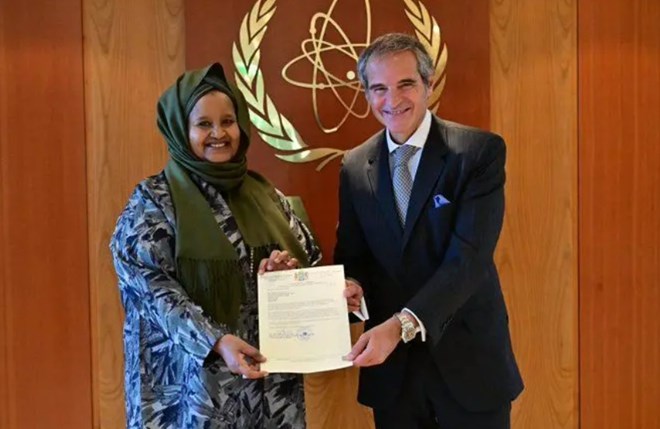
Monday September 8, 2025

Somali Ambassador Khadra Ahmed Dualeh presents her credentials to International Atomic Energy Agency Director General Rafael Mariano Grossi at the agency’s headquarters in Vienna, September 2024. Dualeh is Somalia’s first permanent envoy to the IAEA, following the country’s admission as the agency’s 179th member. (IAEA/Handout)
Mogadishu (HOL) — Somalia is positioning itself to expand access to peaceful nuclear technology after formally joining the International Atomic Energy Agency (IAEA) in September 2024, a step officials say will boost the country’s health care, food security, and energy development.
Somalia’s accession took legal effect on Nov. 15, 2024, when Mogadishu deposited its instrument of acceptance of the IAEA Statute. Somalia is now the agency’s 179th member.
Ambassador Khadra Ahmed Dualeh, Somalia’s envoy to Austria and Switzerland, presented her credentials in Vienna to IAEA Director General Rafael Mariano Grossi. Dualeh became Somalia’s first permanent envoy to the agency, signalling Mogadishu’s ambition to draw on nuclear science for pressing needs back home, from powering hospitals and farms to coping with a changing climate.
Grossi welcomed Somalia’s engagement, saying the IAEA stands ready to support the country. “I look forward to working together to expand access to nuclear science and technology,” he said.
Dualeh described IAEA membership as a strategic milestone. “Somalia will gain technical support and advice on the peaceful use of nuclear energy, particularly in electricity generation. This could reduce reliance on fuel imports while boosting economic development,” she told the BBC.
The IAEA, founded in 1957 under the United Nations system, promotes safe and peaceful uses of nuclear energy worldwide. Its programs assist member states in areas such as cancer diagnosis and treatment, sustainable farming, water management, and environmental protection.
Prime Minister Hamza Abdi Barre’s office described the step as “a historic moment,” framing it as part of Somalia’s wider attempt to rebuild trust abroad while investing in sustainable development. Information Minister Daud Aweis struck a similar note, telling Anadolu that the government hoped to work closely with the international community to channel nuclear technology into tangible gains “for the benefit of our nation,” while stressing the need for rigorous safety and security standards.
In its official statement, the government was keen to emphasize continuity with international norms. It pledged adherence to nonproliferation rules and promised cooperation with fellow IAEA members on peaceful applications such as power generation, radiation protection and nuclear safety. The language was deliberate, emphasizing that nuclear science in Somalia should be associated not with weapons, but with the pursuit of development, security and stability.
The government has also highlighted the role of Almond Energy, a Somali consultancy firm that advised the Ministry of Petroleum and Mineral Resources during the IAEA application process. Almond Energy, a subsidiary of the Almond Group, built its reputation through multimillion-dollar contracts with the United Nations in Somalia, providing logistics, camp management and engineering services in some of the country’s toughest environments. The company has since repositioned itself as the government’s exclusive partner in developing Somalia’s uranium resources, deposits that, by the firm’s own estimates, may lie under as much as 40 percent of Somali territory.
Somalia’s interest in nuclear technology is not new. Back in the 1970s, geologists working with the United Nations discovered small deposits of uranium in the dry central regions of the country. The most promising sites were at Wabo and Mirig, where the mineral was found just below the surface in sun-baked soils. Experts estimated there were a few thousand tons of uranium there, with more possible in nearby areas such as Dusa Mareb and El Bur.
An international survey in the 1980s suggested the country could hold much larger reserves, perhaps as much as 150,000 tons, mostly in the sandy, desert-like plains of Mudugh and Karkar. That prospect was tantalizing at the time, but the global market for uranium was weak, and prices were too low to justify costly mining operations.
Somalia even tried to take the next step. A state-backed company, with help from Arab and Iraqi partners, drew up blueprints for a uranium mine and processing plant. The plan called for a huge operation, able to handle thousands of tons of rock each day. But the numbers didn’t add up: the costs of producing uranium in Somalia were higher than the price it could fetch on the world market, and the project was shelved.
The 1985 report that pulled all these findings together painted a stark picture of Somalia’s capacity at the time. The country’s Geological Survey was short of equipment, its laboratories were underused, and its files and data were poorly managed. Without international support, the report warned, Somalia would struggle to develop its uranium resources.
- With files from the BBC Somali Service
-
Editor’s note: This story has been updated to include historical background on Somalia’s uranium exploration.






